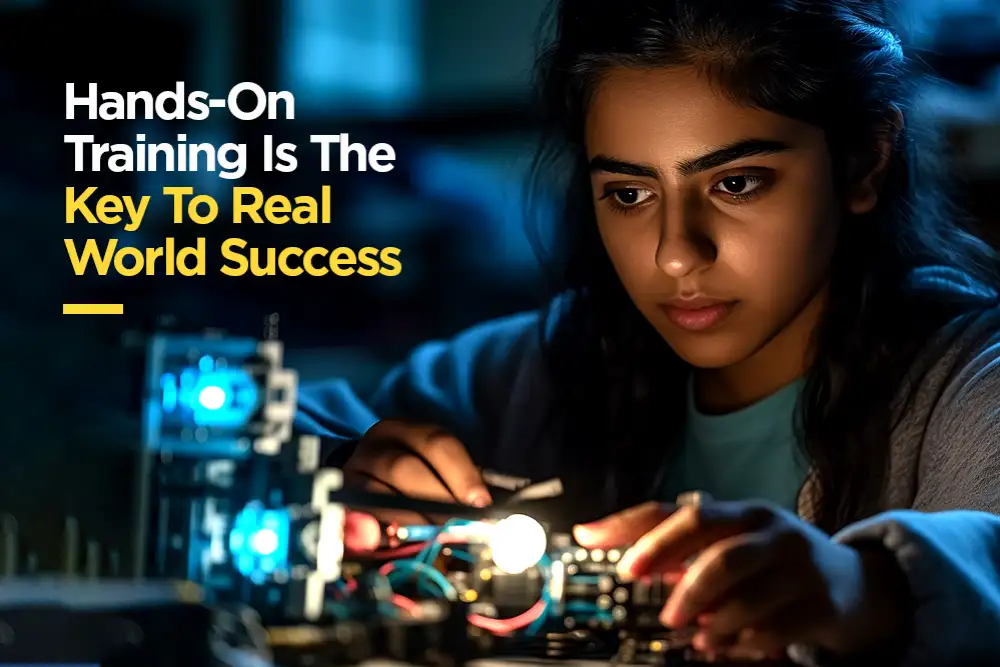Hands-On Training: The Gateway to Real-World Success

The acceleration of technological advancements has ushered in a new era where theoretical knowledge, although fundamental, needs to be improved to guarantee success in both academic and professional realms. This evolving landscape calls for a more hands-on approach to training, establishing it as a cornerstone of education and professional growth. Experiential learning, or learning through doing, is emphasized as a crucial educational approach that bridges the often wide gap between theoretical concepts and their practical applications. This method reinforces the material learned in the classroom and provides invaluable insights that can only be gleaned through firsthand experience.
The benefits of such an approach are myriad, including developing a deeper understanding of the subject matter, cultivating critical thinking and decision-making skills, and applying knowledge in various contexts.
This blog delves deep into practical experience's pivotal role in various academic and professional fields at the best colleges in Maharashtra. It highlights how engaging directly with real-world tasks enhances learning outcomes, nurtures critical problem-solving capabilities, and equips individuals to navigate the complexities of today's professional environments.
The Essence of Hands-On Training
Hands-on training, or experiential learning, involves learning through doing. It's a method where students engage directly with materials, participate in experiments, or work on real-world projects. This approach contrasts with traditional learning methods that rely heavily on lectures, textbooks, and written exams. But why is hands-on training so crucial for success in today’s world?
Enhancing Learning Outcomes
First and foremost, hands-on training enhances learning outcomes. Students understand the material more deeply when applying concepts in real-life scenarios. This understanding is not merely theoretical but rooted in the experience of solving a problem or completing a task. For instance, an engineering student learns by studying the principles of mechanics and applying those principles to build a bridge or design a machine.
Fostering Problem-Solving Skills
Secondly, hands-on training fosters problem-solving skills. In the real world, problems do not come with clear instructions. Students learn to navigate uncertainties, think critically, and devise innovative solutions by engaging in practical tasks during their education. Whether a medical student diagnoses a patient in a clinical setting or a business student develops a marketing strategy for a real company, hands-on experiences teach them to adapt and think independently.
Preparing for Real-world Challenges
Moreover, hands-on training prepares students for real-world challenges. It equips them with the skills and confidence to transition smoothly from academic to professional environments. Employers value graduates who can immediately contribute to the workplace without extensive on-the-job training. Therefore, students exposed to practical learning experiences stand out in the job market.
Bridging the Gap Between Theory and Practice
One of the most significant advantages of hands-on training is its ability to bridge the gap between theory and practice. Many academic disciplines are guilty of teaching concepts that, while theoretically sound, can seem abstract or disconnected from practical application. Experiential learning brings these concepts to life, demonstrating their relevance and applicability in real-world settings.
Examples from Various Fields
In healthcare, for instance, hands-on training through clinical rotations allows medical and nursing students to apply their knowledge in diagnosing and treating patients under the supervision of experienced professionals. Similarly, in engineering, capstone projects require students to design and execute solutions to real-world problems, integrating various engineering principles.
The best colleges in Maharashtraare excellent examples of institutions prioritizing experiential learning. These colleges offer programs that include internships, industrial visits, workshops, and live projects, ensuring that students graduate with a comprehensive understanding of their field, ready to tackle the challenges of the professional world.
The Role of Technology
Technology plays a crucial role in facilitating hands-on training. Simulations, virtual labs, and online platforms allow students to engage in practical learning experiences even when physical resources or settings may be inaccessible. This technological advancement ensures that hands-on training can reach a wider audience, democratizing access to experiential learning.
The Road Ahead
Hands-on training in education and professional development cannot be overstated as we move forward. Academic institutions, industry leaders, and policymakers must collaborate to create more opportunities for practical learning. This collaboration can ensure that tomorrow's workforce is knowledgeable, skilled, adaptable, and ready to meet the challenges of the real world.
Conclusion
In wrapping up our exploration of hands-on training, it's clear that this method transcends the boundaries of a mere educational tool, standing out as a fundamental pillar for success in the ever-evolving landscape of the real world. The value of experiential learning is manifold, enhancing learning outcomes, fostering essential problem-solving skills, and meticulously preparing students to navigate and triumph over the multifaceted challenges that lie ahead. It equips graduates with academic qualifications and the practical prowess necessary to make meaningful contributions to their fields from day one.
Hands-on training is at the heart of preparing a new generation of
professionals capable of leading with insight, acting with confidence, and
innovating with purpose. By championing this mode of learning, the
best colleges in Nagpur
are not just educating students; they are preparing visionaries who will shape
the future of our societies and our world. As we look forward, it is evident
that hands-on training will remain an indispensable part of education,
continually playing a pivotal role in shaping the leaders and innovators who
will navigate the complexities of tomorrow with skill, creativity, and
resilience.
